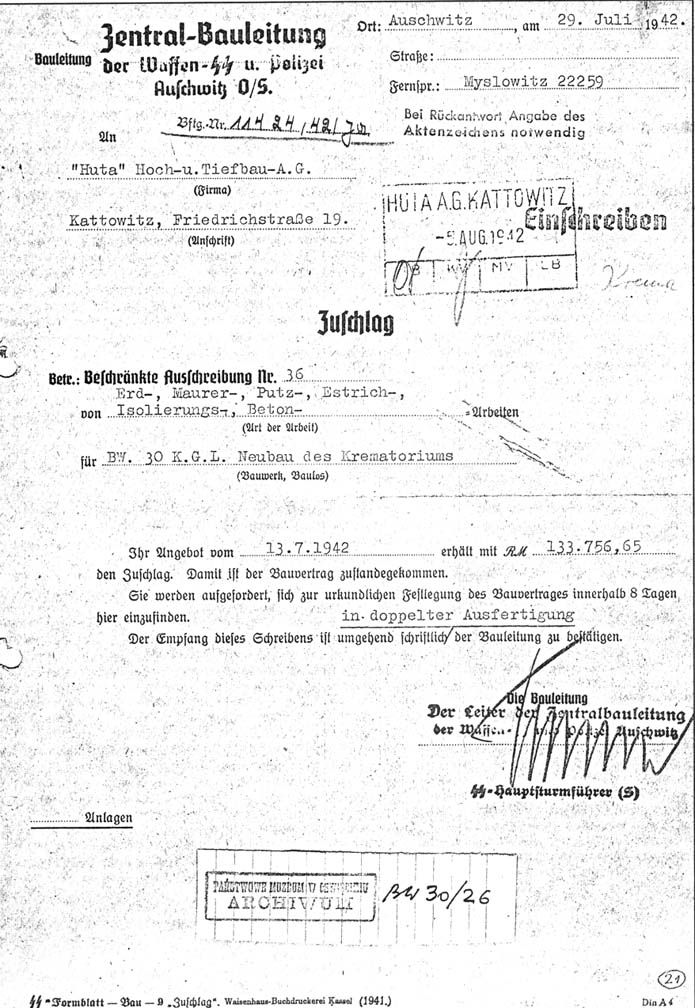On 15th August 1942, a situation plan of the whole POW camp was completed [Document 15], projecting its extension to four construction stages, numbered (from south to north) IV, I, II, III, with a capacity of 60,000, 20,000, 60,000 and 60,000 respectively or a total of 200,000 prisoners. A letter of 27th August 1942, signed by Bischoff and addressed to the SS Construction Inspectorate at Posen for the Head of Office C/V of the SS WVHA in Berlin, confirmed that the “lodging” capacity of the POW camp was to be increased to 200,000 prisoners to [Soviet “October Revolution” Archives, microfilm 295, ref. 7021-108-32, page 41]. A double track railway was still shown between B.I and B.II as well as the construction of TWO crematoriums (labeled 1 and 2, the future Krematorien II and III), which gives 1 muffle for 7,000 prisoners, a proportion considered “normal”. However, the two crematoriums, though certainly still designed without homicidal gas chambers, are formally connected with the SPECIAL ACTIONS [Document 12/II] carried out in Bunkers 1 and 2, i.e. they were to be used essentially to incinerate the corpses from these two installations, which were hitherto buried in mass graves,
The date of 15th August 1942 is to be considered as the end of the gestation period for the FOUR KREMATORIEN of the POW camp and the beginning of their construction. In fact the contracts for the building work on Krematorien II and III were awarded on 29th July The first drawing for the future Krematorium IV [PMO file BW 30b 30c/22, drawing 1678] was produced on 14th August. The contract for the construction of the four chimneys for the TWO OTHER KREMATORIEN (IV and V], of a different model from II and III, was awarded to Messrs Robert Koehler on 20th August 1942 [file BW 30/26, pages 52 and 53]. Thus the incineration capacity of the camp was to be increased to 52 muffles while on 19th August 1942 at the evening roll call there were 22,925 prisoners in the camp.
AS AT MID AUGUST 1942, the criminality of the Krematorien, normally by definition installations planned for health reasons, is evident from the fact that THEIR CAPACITY WAS EXCESSIVE IN RELATION TO THE REAL NEEDS OF THE CAMP, without there being any need to demonstrate the presence of homicidal gas chambers inside them, which is in fact difficult to establish at that date. Although a criminal trace has been detected on drawing 1300 of Krematorium II, it is unique and thus open to dispute, as it can be differently interpreted in relation to other factors. By contrast, drawing 1678 of Krematorium IV (and V) makes it possible to prove that the building was directly planned for criminal purposes, These are the only early traces. The real traces of the installation of homicidal gas chambers in the four Krematorien first appear in mid January 1943 and go on appearing until the end of June 1943. |
| |
|
Document 13
[PMO file BW 30/26, page 21]
Acceptance of tender form, dated 29th July 1942, and sent by the Auschwitz Waffen SS and Police Central Construction Management to Huta, a structural and civil engineering firm, concerning the site preparation, bricklaying, facing, flooring, insulation and concreting work for the new crematorium building BW [worksite] 30 at Birkenau, in accordance with the estimate of 13th July 1942 amounting to 133,756.65 RM. The acceptance was signed by the Head of the Bauleitung, Karl Bischoff, and was received by Huta on 5th August 1942. Two buildings were in fact constructed, the second being the future Krematorium III, worksite 30a. No acceptance of tender has been found for it. |
 |
|
|

